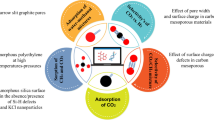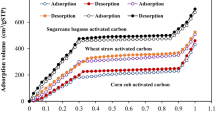Abstract
The goal of the study was to produce a low-cost activated carbon from agricultural residues via single stage carbon dioxide (CO2) activation and to investigate its applicability in capturing CO2 flue gas. The performance of the activated carbon was characterized in terms of the chemical composition, surface morphology as well as textural characteristics. The adsorption capacity was investigated at three temperatures of 25, 50 and 100 °C for different types of adsorbate, such as purified carbon dioxide and binary mixture of carbon dioxide and nitrogen. The purified CO2 adsorption study showed that the greatest adsorption capacity of the optimized activated carbon of 1.79 mmol g−1 was obtained at the lowest operating temperature. In addition, the adsorption study proved that the adsorption capacity for binary mixtures was lower due to the reduction in partial pressure. The experimental values of the purified CO2 adsorption were modelled by the Lagergren pseudo-first-order model, pseudo-second-order model, and intra-particle diffusion model. Based on the analysis, it inferred that the adsorption of CO2 followed the pseudo-second-order model with regression coefficient value higher than 0.995. In addition, the adsorption study was governed by both film diffusion and intra-particle diffusion. The activation energy that was lesser than 25 kJ mol−1 implied that physical adsorption (physisorption) occurred.




Similar content being viewed by others
References
Allen S, Whitten L, McKay G (1998) The production and characterisation of activated carbons: a review. Dev Chem Eng Miner Process 6:231–261
Ayoob S, Gupta AK, Bhakat PB, Bhat V (2008) Investigations on the kinetics and mechanisms of sorptive removal of fluoride from water using alumina cement granules. Chem Eng J 140:6–14
Basu S, Henshaw PF, Biswas N, Kwan HK (2002) Prediction of gas-phase adsorption isotherms using neural nets. Can J Chem Eng 80:1–7
Chouchene A, Jeguirim M, Trouvé G (2013) Biosorption performance, combustion behaviour, and leaching characteristics of olive solid waste during the removal of copper and nickel from aqueous solutions. Clean Technol Environ Policy. doi:10.1007/s10098-013-0680-9
Dantas TL, Rodrigues AE, Moreira RF (2012) Separation of carbon dioxide from flue gas using adsorption on porous solids. In: Liu G (Ed) Greenhouse gases: capturing, utilization and reduction, InTech
Elkady MF, Ibrahim AM, El-Latif MMA (2011) Assessment of the adsorption kinetics, equilibrium and thermodynamic for the potential removal of reactive red dye using eggshell biocomposite beads. Desalin 278:412–423
Hamdan ME, Man N, Yassin SM, D’Silva JL, Shaffril HM (2013) Farmers’ adaptive capacity towards the impacts of global warming: a review. Asian Soc Sci 9:177–184
Hileman B (2006) Climate change threatens global economy. Chem Eng News 84:7–8
Ho YS, McKay G (1998) A comparison of chemisorption kinetic models applied to pollutant removal on various sorbents. Process Saf Environ Prot 76:332–340
Juttke V, Richter H, Voight I, Prasad RM, Bazarjani MS, Gurlo A, Riedel R (2013) Polymer derived ceramic membranes for gas separation. Chem Eng Trans 32:1891–1896
Kaithwas A, Prasad M, Kulshreshtha A, Verma S (2012) Industrial wastes derived solid adsorbents for CO2 capture: a mini review. Chem Eng Res Des 90:1632–1641
Kangwanwatana W, Saiwan C, Tontiwachwuthikul P (2013) Study of CO2 adsorption using adsorbent modified with piperazine. Chem Eng Trans 35:403–408
Khare P, Kumar A (2012) Removal of phenol from aqueous solution using carbonized Terminalia chebula-activated carbon: process parametric optimization using conventional method and Taguchi experimental design, adsorption kinetic, equilibrium and thermodynamic study. Appl Water Sci 2:317–326
Kurane I (2010) The effect of global warming on infectious diseases. Osong Public Health Res Perspect 1:4–9
Kwon S, Fan M, DaCosta HFM, Russell AG, Berchtold KA, Dubey MK (2011) CO2 sorption (Chap. 10). In: Bell DA, Towler BF, Fan M (eds) Coal gasification and its applications, 1st edn. William Andrew, Boston, pp 293–339
Li W, Zhang L, Peng J, Li N, Zhu X (2008) Preparation of high surface area activated carbons from tobacco stems with K2CO3 activation using microwave radiation. Ind Crop Prod 27:341–347
Linga P, Kumar R, Englezos P (2007) The clathrate hydrate process for post and pre-combustion capture of carbon dioxide. J Hazard Mater 149:625–629
Maroto-Valer MM, Tang Z, Zhang Y (2005) CO2 capture by activated and impregnated anthracites. Fuel Process Technol 86:1487–1502
Marx D, Joss L, Hefti M, Pini R, Mazzotti M (2013) The role of water in adsorption-based CO2 capture systems. Energy Proced 37:107–114
Meng L, Park S (2012) Investigation of narrow pore size distribution on carbon dioxide capture of nanoporous carbons. Bull Korean Chem Soc 33:3749–3754
Murshid G, Shariff AM, Keong LK, Bustam AM (2011) Thermo physical analysis of 2-amino-2-methyl-1-propanol solvent for carbon dioxide removal. Chem Eng Trans 25:45–50
Özcan A, Öncü EM, Özcan AS (2006) Kinetics, isotherm and thermodynamic studies of adsorption of Acid Blue 193 from aqueous solutions onto natural sepiolite. Colloids Surf Physicochem Eng Asp 277:90–97
Plaza MG, González AS, Pevida C, Pis JJ, Rubiera F (2012) Valorisation of spent coffee grounds as CO2 adsorbents for postcombustion capture applications. Appl Energy 99:272–279
Purba E, Taharuddin T (2010) CO2 reduction and production of algal oil using microalgae Nannochloropsis oculata and Tetraselmis chuii. Chem Eng Trans 21:397–402
Rashidi NA, Yusup S, Hameed BH (2013) Kinetic studies on carbon dioxide capture using lignocellulosic based activated carbon. Energy 61:440–446
Renugadevi N, Sangeetha, Lalitha P (2011) Kinetics of the adsorption of methylene blue from an industrial dyeing effluent onto activated carbon prepared from the fruits of Mimusops elengi. Arch Appl Sci Res 3:492–498
Richards J (1995) Control of gaseous emissions: Student manual, APTI Course 415. North Carolina State University, Raleigh
Sadaf S, Bhatti HN (2013) Evaluation of peanut husk as a novel, low cost biosorbent for the removal of Indosol Orange RSN dye from aqueous solutions: batch and fixed bed studies. Clean Technol Environ Policy. doi:10.1007/s10098-013-0653-z
Saiwan C, Srisuwanvichein S, Tontiwachwuthikul P (2013) Biopolymer modified with piperazine-2-carboxylic acid for carbon dioxide adsorption. Chem Eng Trans 35:397–402
Shih WH, Tejas P, Qiang Z (2003) Development of mesoporous membrane materials for CO2 separation. http://www.fischer-tropsch.org/DOE/DOE_reports/40823/40823-final/40823-final.pdf. Accessed 2 Dec 2013
Wang Y, Liu B, Zheng C (2010) Preparation and adsorption properties of corncob-derived activated carbon with high surface area. J Chem Eng Data 55:4669–4676
Wickramaratne NP, Jaroniec M (2013) Importance of small micropores in CO2 capture by phenolic resin-based activated carbon spheres. J Mater Chem A 1:112–116
Winters WJ, Dugan B, Collett TS (2008) Physical properties of sediments from Keathley Canyon and Atwater Valley, JIP Gulf of Mexico gas hydrate drilling program. Mar Pet Geol 25:896–905
Xu D, Zhang J, Li G, Xiao P, Webley P, Zhai YC (2011) Effect of water vapor from power station flue gas on CO2 capture by vacuum swing adsorption with activated carbon. J Fuel Chem Technol 39:169–174
Xu D, Xiao P, Zhang J, Li G, Xiao G, Webley PA, Zhai Y (2013) Effects of water vapour on CO2 capture with vacuum swing adsorption using activated carbon. Chem Eng J 230:64–72
Acknowledgments
The authors would like to acknowledge the Top-Down Nanotechnology Research Grant (NND/NA/(1)/TD11-036) under Ministry of Science, Technology and Innovation and Universiti Teknologi PETRONAS for both the financial and technical assistance.
Author information
Authors and Affiliations
Corresponding author
Rights and permissions
About this article
Cite this article
Rashidi, N.A., Yusup, S., Borhan, A. et al. Experimental and modelling studies of carbon dioxide adsorption by porous biomass derived activated carbon. Clean Techn Environ Policy 16, 1353–1361 (2014). https://doi.org/10.1007/s10098-014-0788-6
Received:
Accepted:
Published:
Issue Date:
DOI: https://doi.org/10.1007/s10098-014-0788-6




